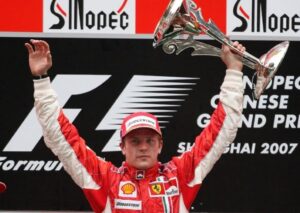
In the high-stakes, high-tech world of Formula 1, marginal gains can make the difference between victory and obscurity. But for Kimi Räikkönen, one of the sport’s most enigmatic champions, his edge wasn’t just found in the wind tunnel or on the simulator — it was embedded in his body and mindset.
According to Räikkönen’s former trainer, Mark Arnall, the Finnish driver possessed a “massive” natural advantage over his competitors: an extraordinary ability to remain physically calm under pressure, even in the most chaotic situations.
“Kimi’s heart rate during races was ridiculously low compared to other drivers,” Arnall revealed during a recent podcast interview. “Even in intense situations — wheel-to-wheel battles, rain races, pit lane chaos — his body hardly registered stress. That gave him an edge no simulator could replicate.”
Where most F1 drivers would be operating at heart rates of 160–180 bpm, Räikkönen often hovered around 120–130 bpm, even under heavy G-forces and extreme mental load. This ability to stay physically relaxed not only improved his concentration and reflexes, but also helped conserve energy during long races.
“He was calm on the outside and calm on the inside. That’s not something you can train — it’s something you’re born with,” said Arnall.
Another underrated weapon in Räikkönen’s arsenal, according to Arnall, was his uncomplicated mindset.
“Kimi didn’t overthink. He didn’t panic. He didn’t waste mental energy on what-ifs. He trusted his instincts and stuck to the basics. That’s rare in F1, where drivers are constantly bombarded with data, strategy, and pressure.”
This approach often left rivals baffled. While others dissected telemetry and strategies late into the night, Kimi would go to sleep early — and win the race the next day. His minimalist mentality wasn’t laziness; it was focus.
Beyond his mental strengths, Räikkönen’s physical conditioning was elite — often underrated because of his laid-back image. Arnall, who worked with him for over two decades, said that behind the sunglasses and monosyllabic answers was a disciplined, naturally gifted athlete.
“His recovery time, his coordination, his adaptability — all of it was top-tier. And he hated drama. He just wanted to do the work and race.”
Kimi’s unique blend of mental calmness, physical resilience, and pure talent culminated in his 2007 World Championship — and kept him competitive for nearly two decades across multiple eras of Formula 1.
His longevity in the sport, despite taking two years off to rally and race NASCAR, was no accident. It was the result of a driver whose body and mind operated in perfect sync — unaffected by hype, pressure, or politics.
In an age where athletes are often micromanaged to perfection, Kimi Räikkönen stood out as a natural — an anti-hero who refused to complicate things.
“People always talk about his one-liners and the Iceman attitude,” Arnall concluded. “But behind it was a physiology and mental state built for greatness. That was his real advantage — and it was massive.”
And in the world of Formula 1, where cool heads win hot races,
no one was cooler than Kimi.









